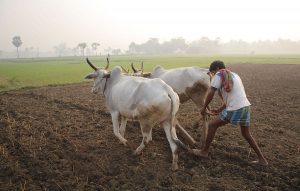While India’s ban on selling cattle for slaughter has triggered violent vigilantism, Peter Mayer and Mandar Oak consider its impact on the country’s economy
It is common knowledge that the cow is held as sacred by many Hindus. As the English usage is ambiguous, it is important to specify that it is only females of the species bos taurus which are revered. Bulls and water buffalos are not traditionally considered to be sacred.
Under the Constitution of India, the regulation of animal markets and slaughterhouses is reserved for the individual Indian states. Until recently, the slaughter of bulls and buffalos, with some restrictions, was permitted in about half of the states.
‘Beef ban’ forbids the sale for slaughter in animal markets of cattle of all kinds
Late in May this year, however, the Modi government passed a rule, popularly termed ‘the beef ban’, forbidding the sale for slaughter in animal markets of cattle of all kinds—old, unproductive and even including camels!
Although the ostensible purpose of this rule is to prevent cruelty to animals, it is widely understood to be a legal means for the central government in New Delhi to outlaw cow slaughter— a policy meant to please the Hindu nationalist base of Narendra Modi’s Bharatiya Janata Party.
In this sense, the rule could be seen as a justification for the violence and vigilantism perpetrated in the name of cow protection.
Protests are growing in India against both the growth of vigilante lawlessness and an apparent toleration of mob violence by BJP governments at state and national level. In different states such as Kerala and Tamil Nadu there have also been legal challenges to the constitutionality of the beef ban.
Economic consequences
While it remains to be seen if adverse political consequences flow from the ban on cow slaughter, there is no ambiguity about the foreseeable economic consequences of the policy.
India is the world’s largest exporter of beef by volume, ahead of Australia and Brazil. In the financial year 2016-17, beef (predominantly buffalo meat), leather and leather products together accounted for $10 billion in export revenues and employed 3.5 million people. For comparison’s sake, the Indian IT sector earned $108 billion in export revenues and employed nearly 3.5 million people.
Concerns in the international market about reduced beef supply from India have led to a 2.5 per cent rise in the beef price.

Beef and leather exports will not be the only sectors affected by the beef ban.
Cattle in India are not explicitly raised for beef or leather. They are used as draught animals and for milk, and only at the end of their productive lives are they sold to the butchers, or transported to other states—or smuggled to neighbouring countries.
A ban on sale for slaughter will cripple the very market that enables farmers and dairy operators to recover a crucial part of the value of their cattle and to replenish the old stocks with new. A study by India’s National Dairy Development Board is reported to have found that 47 per cent of a dairy farmer’s profits come from selling his old cows .
India’s domestic beef market is nearly as big as the export market
So the cattle ban is bound to cause loss and hardship in the dairy and farming sectors as well.
[ratina][/ratina]Moreover, the distributional consequences of the beef ban will be disastrous. Beef is a cheap source of protein for non-caste Hindus as well as the Muslim minority—Dalits and Muslims alone make up over 30 per cent of the Indian population.
The domestic market in beef is currently nearly as big as the export market.
People employed in the beef and leather industry, as well as in marginal agriculture where draught cattle are still used, are predominantly from the lower economic strata. In enacting the beef ban, the government has shown itself, much like it did during the demonetisation saga, to be tone-deaf to the concerns of the poor, rural and marginal sections of the society.
In pleasing its political base, the BJP government has both weakened India’s social solidarity and hamstrung its position in the beef market. At the same time, it has done little to prevent cruelty to animals, the ostensible raison d’être for its ban.
This own-goal by a major competitor will certainly put a smile on the faces of cattle producers in Australia. Sadly, but surely, one man’s misery can become another’s opportunity.
Postscript: The Supreme Court of India has just issued a temporary stay order on the cow slaughter regulation.
Featured image: Villager and calf milk cow in Rajasthan, India Photo: ILRI Stevie Mann Source: Wikimedia Commons
